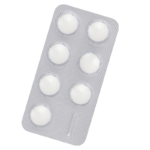Athlete's foot
Effective treatments for fungal infections of the feet.
Secure delivery
UK clinicians
Athlete’s foot is a common fungal infection that affects the feet. The infection usually occurs on the skin of the feet and between the toes, but can also spread to the toenails and hands. It usually causes itching, cracked and dry skin, and sometimes blisters and sores.
Athlete’s foot is caused by a group of fungi called dermatophytes. These fungi thrive in warm and moist conditions. They feed on keratin, a protein found in nails, skin and hair.
The condition is contagious and can be passed from one person to another through skin particles. It can spread through contact with an infected person or from contact with contaminated surfaces, such as towels, floors and shoes. Once the infected skin comes into contact with broken skin it can quickly and easily transfer.
Athlete’s foot (as the name suggests) is typically experienced by people who take part in sports, especially sports that cause sweating (like running) or involve bare feet (like swimming and judo). This is because their feet often sweat in trainers and create the perfect environment for the fungi to thrive.
It’s also common in people who work in jobs where they come into contact with water and also people who work in industrial settings.
The highly contagious nature of athlete’s foot means that it affects a large number of people. It often spreads in the family home and in primary schools where children participate in PE lessons in bare feet.
Approximately 15% of the UK population suffers with athlete’s foot, with the highest rates seen in men over the age of 16.
Over 70% of people will have athlete’s foot at least once in their lives. It usually occurs between the toes but can also infect the hands. Sometimes it can spread to the sole of the foot where it causes dry and cracked skin.
Both children and adults can get athlete’s foot, although it’s more common in men and older people and those who participate in sports or work in damp conditions.
Swimming pool users and people who work in industrial settings are the most likely to get athlete’s foot.

How we source info.
When we present you with stats, data, opinion or a consensus, we’ll tell you where this came from. And we’ll only present data as clinically reliable if it’s come from a reputable source, such as a state or government-funded health body, a peer-reviewed medical journal, or a recognised analytics or data body. Read more in our editorial policy.
Athlete’s foot is caused by a fungus called dermatophytes. This type of fungi thrives in warm and moist conditions (like a sweaty sock or trainer). The fungi enters the body through cracks and splits in the skin.
Once the fungus is in the skin it continues to thrive in the warm and moist conditions and spreads around the foot.
Athlete’s foot spreads from one person to another when skin flakes are transferred from an infected foot. This typically occurs in communal showers or in changing rooms where people walk around with bare feet after exercising. It can also happen when people share trainers or other sporting equipment carrying infected skin flakes. Sharing towels is a common way to spread the infection.
It can recur if socks and shoes are not washed or discarded following infection.
The symptoms of athlete’s foot are usually seen between the toes, but can appear on the sole of the foot, in toenails and on hands.
Typical symptoms include:
Athlete’s foot is very common and is often not serious, but left untreated it can sometimes lead to nail infections that are tricky to treat.
In very rare cases, the infection can spread to the lymph nodes. This can lead to an infection in the vessels of the lymph nodes called lymphangitis.
If you don’t treat your athlete's foot, there’s also a chance that the skin may crack, leading to bacterial skin infection.
If you have diabetes, you should be vigilant when it comes to athlete’s foot because you’re at a greater risk of developing it than the general population, due to the unique composition of your sweat.

How we source info.
When we present you with stats, data, opinion or a consensus, we’ll tell you where this came from. And we’ll only present data as clinically reliable if it’s come from a reputable source, such as a state or government-funded health body, a peer-reviewed medical journal, or a recognised analytics or data body. Read more in our editorial policy.

How we source info.
When we present you with stats, data, opinion or a consensus, we’ll tell you where this came from. And we’ll only present data as clinically reliable if it’s come from a reputable source, such as a state or government-funded health body, a peer-reviewed medical journal, or a recognised analytics or data body. Read more in our editorial policy.
Have something specific you want to know? Search our info below, or ask our experts a question if you can’t find what you’re looking for.
Athlete’s foot. BMJ Clinical Evidence, 2009.
Athlete’s foot. BMJ Clinical Evidence, 2009.
Topical treatment of common superficial tinea infections. American Family Physician, 65(10), pp.2095–2102.

Like Terbinafine, but the branded version. Treatment to kill the fungi that causes your infection.

Topical cream and oral tablets for fungal infections like athlete's foot and ringworm.

Choose between a cream or powder to get rid of fungal infections.

Registered with GMC (No. 4624794)
Meet Daniel
Registered with GPhC (No. 2202465)
Meet Sanjeda
Registered with GPhC (No. 2070724)
Meet Craig
Always read the leaflet that comes with your medication and tell us about any side effects you get.
We know health, but you know you.
Our experts tell you what’s safe, but you decide what’s best.
Answer a few questions and tell us about yourself. Get tailored advice from our clinicians so you can choose better.

Choose your treatment and how often you have it delivered.

We know things change. It’s the nature of life. We’ll check in regularly to make sure your treatment is still right for you.
Pause. Change. Skip. Start again. Any time you like.
Here are some other things we can help with.
Choose from our range of tablets and solutions. Get ongoing care and support from our experts.
Stop smoking treatments that can help you kick the habit forever, and reduce your risk of disease.
Tablets or injections. Tailored weight loss treatments combined with ongoing support from our experts.
We're making healthcare more about you. Sign up to our newsletter for personalised health articles that make a difference.
Disclaimer: The information provided on this page is not a substitute for professional medical advice, diagnosis, or treatment. If you have any questions or concerns about your health, please talk to a doctor.
We couldn't find what you're looking for.
Here's everything we treat. Or, if you're looking for something we don't have yet, you can suggest something.
If there’s a particular treatment or condition you’re looking for, tell us and we’ll look into it for you.
Submit your question here, or tell us if you’ve found an issue on our site.
We’ll get back to you very soon. We aim to respond to all queries in one working day.
You’re signed up to our newsletter. Keep an eye on your inbox for our latest update.
By clicking 'Subscribe now' you're agreeing to our Privacy Policy.
We’ve sent you an email asking you to confirm your email address.